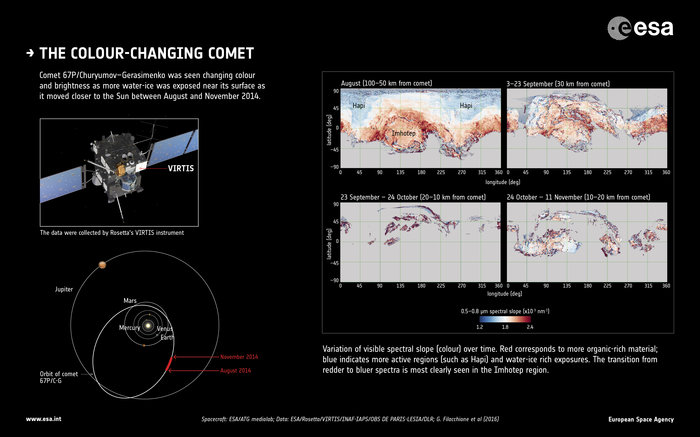
Rosetta will allow scientists to look back 4600 million years to an epoch when no planets existed
and only a vast swarm of asteroids and comets surrounded the Sun
ESA's Rosetta spacecraft
will unlock the mysteries of the oldest building blocks of our Solar System – the comets
What are the mission’s objectives
Rosetta's prime objective is to help understand the origin and evolution of the Solar System. The comet’s composition reflects the composition of the pre-solar nebula out of which the Sun and the planets of the Solar System formed, more than 4.6 billion years ago
What makes the Rosetta mission so special?
Rosetta will be undertaking several ‘firsts’ in space exploration. It will be the first mission to orbit and land on a comet. That makes Rosetta one of the most complex and ambitious missions ever undertaken. Scientists had to plan in advance, in the greatest possible detail, a ten year trip through the Solar System. Approaching, orbiting, and landing on a comet require delicate and spectacular manoeuvres. The comet, 67P/Churyumov-Gerasimenko, is a relatively small object, about 4 kilometres in diameter, moving at a speed as great as 135,000 kilometres per hour. We know very little about its actual surface properties – only when we get there will we be able to explore the surface in such detail that we can choose a safe landing scenario. Rosetta is very special because of the unique science it will perform. No other previous mission has had Rosetta’s potential to look back to the infant Solar System and investigate the role comets may have played in the beginnings of life on EartWhat makes the Rosetta mission so special?
Rosetta will be undertaking several ‘firsts’ in space exploration. It will be the first mission to orbit and land on a comet. That makes Rosetta one of the most complex and ambitious missions ever undertaken. Scientists had to plan in advance, in the greatest possible detail, a ten year trip through the Solar System. Approaching, orbiting, and landing on a comet require delicate and spectacular manoeuvres. The comet, 67P/Churyumov-Gerasimenko, is a relatively small object, about 4 kilometres in diameter, moving at a speed as great as 135,000 kilometres per hour. We know very little about its actual surface properties – only when we get there will we be able to explore the surface in such detail that we can choose a safe landing scenario. Rosetta is very special because of the unique science it will perform. No other previous mission has had Rosetta’s potential to look back to the infant Solar System and investigate the role comets may have played in the beginnings of life on Earth
However, it took some time before the Solar System became the way it is now. About 4.5 billion years ago, it was still 'under construction', and interplanetary space was littered with conglomerates of dust particles. Many of these chunks hit the planets and were destroyed in the collision, but thousands of millions of them survived – they are the asteroids and comets we know today.